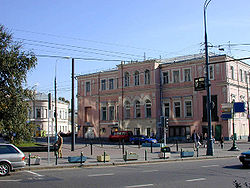
Nikitsky Boulevard
Encyclopedia

Russian language
Russian is a Slavic language used primarily in Russia, Belarus, Uzbekistan, Kazakhstan, Tajikistan and Kyrgyzstan. It is an unofficial but widely spoken language in Ukraine, Moldova, Latvia, Turkmenistan and Estonia and, to a lesser extent, the other countries that were once constituent republics...
: Никитский бульвар, is a boulevard
Boulevard
A Boulevard is type of road, usually a wide, multi-lane arterial thoroughfare, divided with a median down the centre, and roadways along each side designed as slow travel and parking lanes and for bicycle and pedestrian usage, often with an above-average quality of landscaping and scenery...
in central Moscow
Moscow
Moscow is the capital, the most populous city, and the most populous federal subject of Russia. The city is a major political, economic, cultural, scientific, religious, financial, educational, and transportation centre of Russia and the continent...
, Russia
Russia
Russia or , officially known as both Russia and the Russian Federation , is a country in northern Eurasia. It is a federal semi-presidential republic, comprising 83 federal subjects...
. The boulevard is a part of the Boulevard Ring
Boulevard Ring
The Boulevard Ring is Moscow's second centremost ring road . Boulevards form a semicircular chain along the western, northern and eastern sides of the historical White City of Moscow; in the south the incomplete ring is terminated by the embankments of Moskva River...
, connecting Arbat Square
Arbat Square
Arbatskaya Square of Arbat Square is one of the oldest squares of Moscow, located on the junction of Gogolevsky Boulevard, Znamenka Street and Arbat Gates Square ....
with Nikitskie Vorota square at the crossing with the Nikitsky Street. The actual green boulevard extends for only two thirds of the street; its southern part was razed in the 1960s to make way for a tunnel under the Arbat Square. In 1950 the street was renamed Suvopovskiy Boulevard, Russian
Russian language
Russian is a Slavic language used primarily in Russia, Belarus, Uzbekistan, Kazakhstan, Tajikistan and Kyrgyzstan. It is an unofficial but widely spoken language in Ukraine, Moldova, Latvia, Turkmenistan and Estonia and, to a lesser extent, the other countries that were once constituent republics...
: Суворовский Бульвар in honour of generalissimus Alexander Suvorov
Alexander Suvorov
Alexander Vasilyevich Suvorov , Count Suvorov of Rymnik, Prince in Italy, Count of the Holy Roman Empire , was the fourth and last generalissimo of the Russian Empire.One of the few great generals in history who never lost a battle along with the likes of Alexander...
. The old street name was reinstated in 1994.
The street is home to a monument of writer Nikolai Gogol
Nikolai Gogol
Nikolai Vasilievich Gogol was a Ukrainian-born Russian dramatist and novelist.Considered by his contemporaries one of the preeminent figures of the natural school of Russian literary realism, later critics have found in Gogol's work a fundamentally romantic sensibility, with strains of Surrealism...
, placed deep in the courtyard of an 18th century Talyzin mansion where the author spent his last few years 1848-1852 and where he burned the manuscript of the second volume of the Dead Souls
Dead Souls
Dead Souls is a novel by Nikolai Gogol, first published in 1842, and widely regarded as an exemplar of 19th-century Russian literature. Gogol himself saw it as an "epic poem in prose", and within the book as a "novel in verse". Despite supposedly completing the trilogy's second part, Gogol...
in a fit 'sent by the devil.' This monument by sculptor Nikolay Andreyev
Nikolay Andreyev
Nikolay Andreyevich Andreyev was a Russian sculptor, graphic artist and stage designer. As a young man Andreyev studied with Sergey Volnukhin and in 1902 became associated with the Peredvizhniki group of realists. Andreyev's brother V.A. Andreyev was also a sculptor.Andreyev was the designer of...
depicted Gogol in a state of depression and originally (from 1909) stood on the northern tip of Gogolevsky Boulevard but, apparently due to Stalin's dislike of this depiction, was relocated in 1951 to its current place. A second monument to Gogol by sculptor Nikolai Tomsky
Nikolai Tomsky
Nikolai Vasilyevich Tomsky was a much-decorated Soviet sculptor, designer of many well-known ceremonial monuments of the Socialist Realism era.- Biography :...
(a much more socialist-realist effort, which shows no signs of Gogol's mental state) replaced the old one at the old site in 1956.

